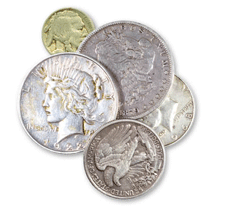Somewhere in a dark corner of my garage, entombed with my fifth grade report card and other childhood keepsakes, is a 4-inch by 4-inch wooden box filled with coins—a jumble of silver dollars, wheat pennies and "old" nickels I collected as a kid. I've packed them from state to state for more than 40 years, presumably convinced that someday I would drag them out and—what? Put them in a binder? Sell them on eBay? Use them to pay the bridge toll?
My unwillingness to part with those coins has nothing to do with their utility. I couldn't even tell you how much they're worth. I keep them, I suppose, because they've outlived just about everything else I've ever owned, and they provide a tangible connection to my youth.
I am much less sentimental about everyday nickels and dimes. I don't want them, try to avoid them, and can't see any logical reason to still have them in circulation. And now I find out, in Kara Platoni's story, that it actually costs more to make them than they're worth.
In this age of electronic banking and card-swipe transactions, is physical money necessary? Platoni explores that question and reveals how some Stanford folks are trying to find better ways to pay for things. There are legitimate reasons to do so—for example, because being strapped to cash makes it harder for poor people to work their way up.
To test the notion that cash is outmoded, David Wolman, MA '00, author of The End of Money, lived for a year without carrying money. He ran into trouble in a few places, but found that on the whole society already has adopted a cashless economy. With a little nudge, he asserts, we could do away with the cold, hard stuff.
I decided to mimic Wolman's research for one week, eschewing cash to see how difficult it would be to live without it. Didn't go so well.
First test: I accompany a colleague to the alumni association café to buy a coffee. She pays with cash and tosses the change into the tip cup next to the register. This seems like good form, but I only have a debit card and no way to write in a gratuity. Chalk one up for cash.
I'm golfing with friends, which is mostly an excuse for elaborate wagers such as Fewest Putts After Landing on the Green in Regulation. At lunch the losers pay up and as fives and tens cross the table, I scramble for a way out. "Uh, how about I pay for everybody's lunch?" Weak, but it works.
Sunday morning I join a friend at a quaint mom-and-pop restaurant in Los Altos. The menus arrive and I note, with a small knot in my stomach, the words "cash only" printed in large letters on the front. "I have a few dollars," my friend offers, graciously. Saved again.
Next, cash finds me. I rent an apartment to a recent Stanford graduate who pays me with 18 crisp $100 bills. I so seldom touch money anymore, let alone a wad like that, the sensation is a little thrilling, like I just made a score. Yet I can't help feeling like I should sprint to the nearest bank and get it out of my hands. What good can come from hauling around 1,800 bucks?
The next day I head to an outdoor gear store to provision for a backpacking trip. They are agnostic about how I pay, and I fork over the credit card. As with my earlier experiences, this final foray into commerce brings me no closer to proving that cash is dead. It only serves to underscore an undeniable truth: I am really good at getting rid of money.
Kevin Cool is the executive editor of Stanford.



